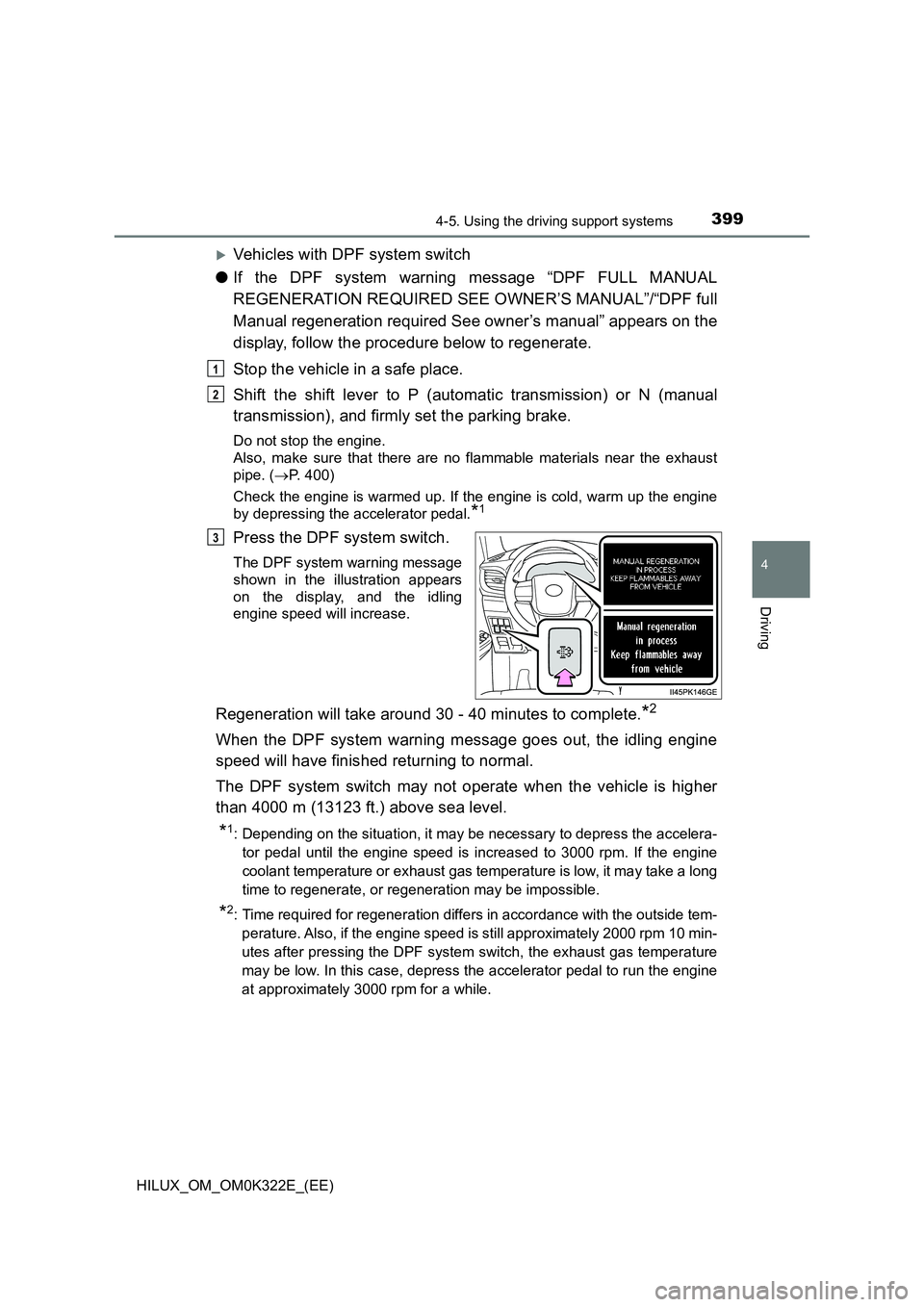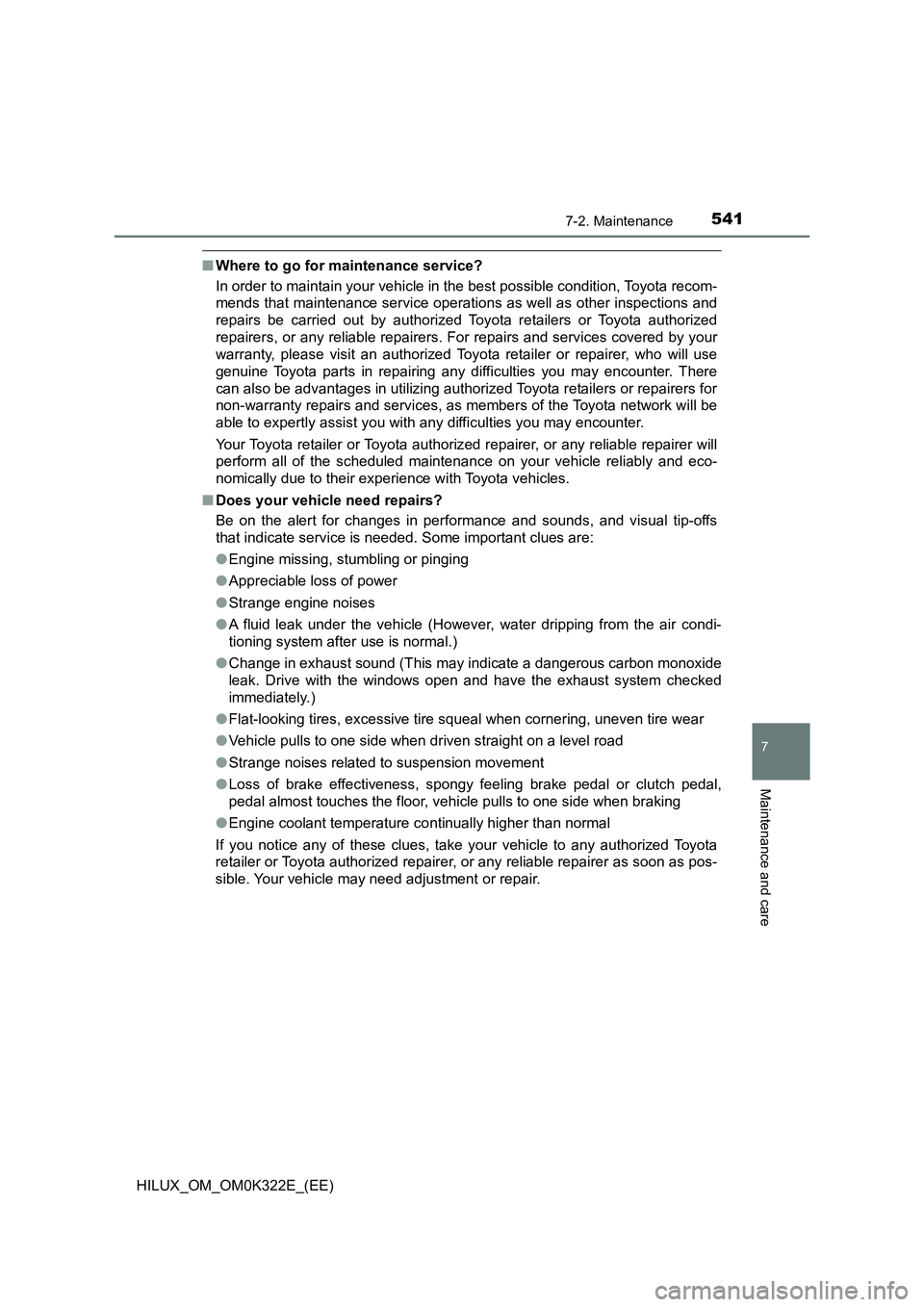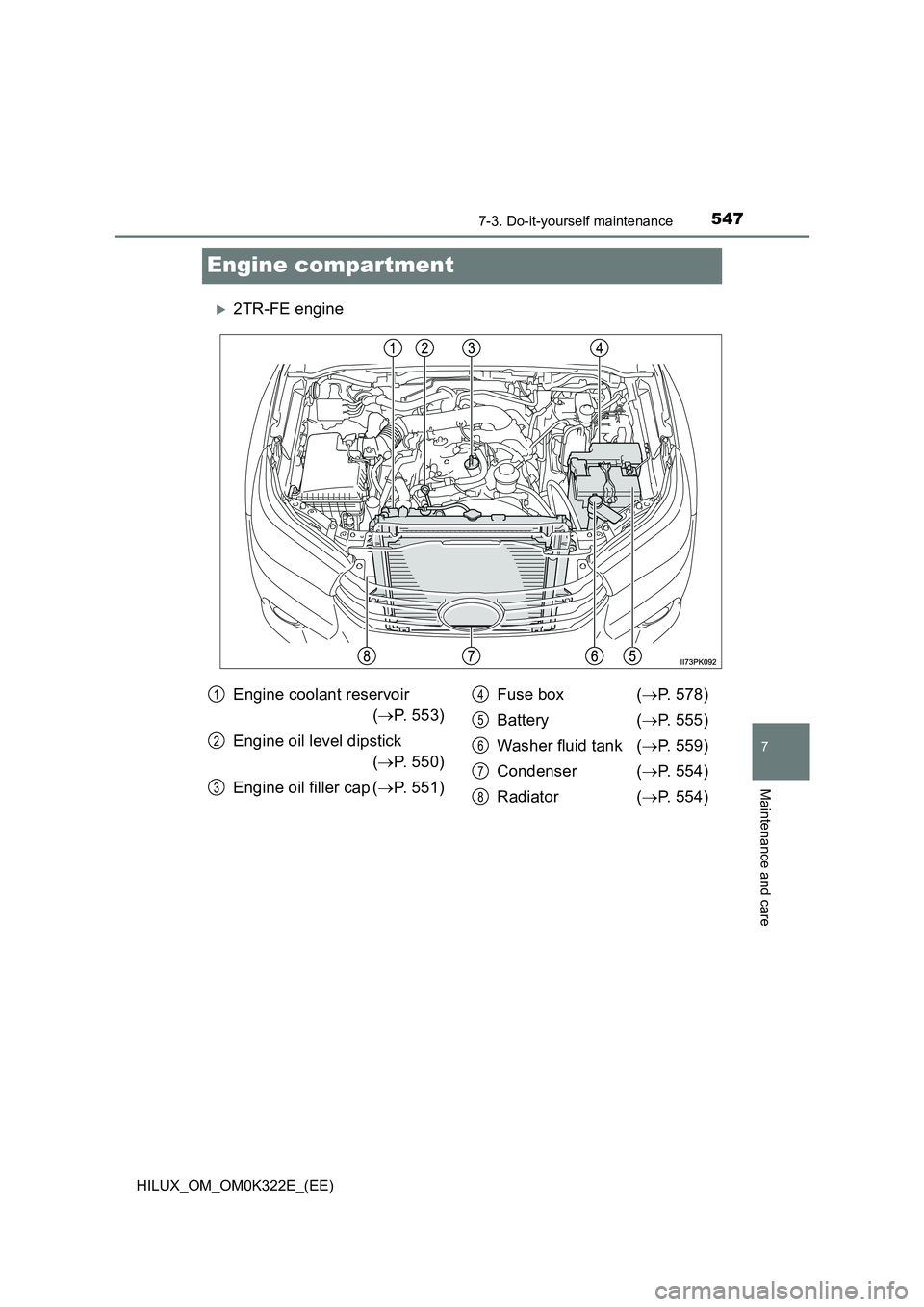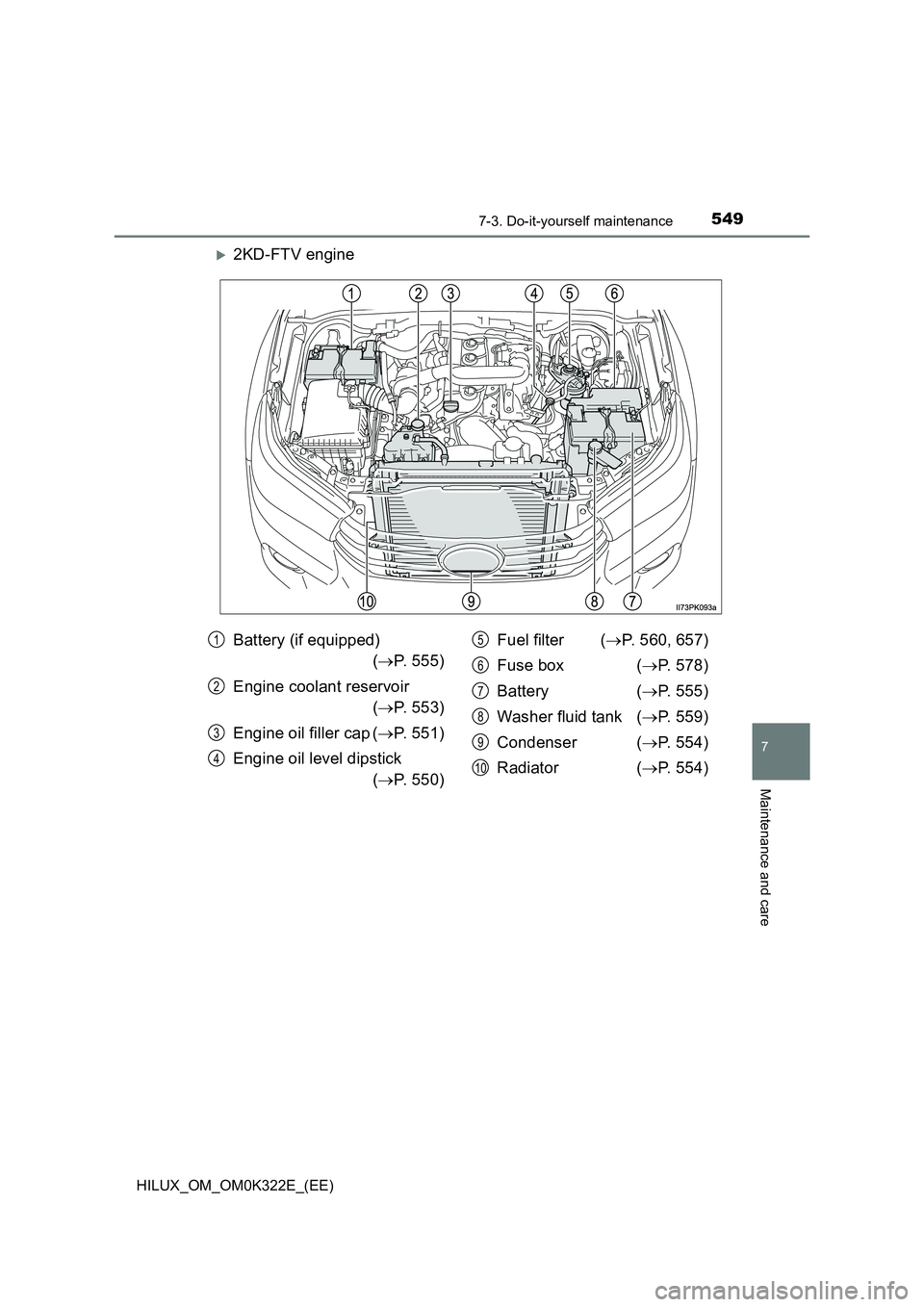coolant level TOYOTA HILUX 2017 Owners Manual (in English)
[x] Cancel search | Manufacturer: TOYOTA, Model Year: 2017, Model line: HILUX, Model: TOYOTA HILUX 2017Pages: 720, PDF Size: 112.19 MB
Page 399 of 720

3994-5. Using the driving support systems
4
Driving
HILUX_OM_OM0K322E_(EE)
Vehicles with DPF system switch
● If the DPF system warning message “DPF FULL MANUAL
REGENERATION REQUIRED SEE OWNER’S MANUAL”/“DPF full
Manual regeneration required See owner’s manual” appears on the
display, follow the procedure below to regenerate.
Stop the vehicle in a safe place.
Shift the shift lever to P (automatic transmission) or N (manual
transmission), and firmly set the parking brake.
Do not stop the engine.
Also, make sure that there are no flammable materials near the exhaust
pipe. ( P. 400)
Check the engine is warmed up. If the engine is cold, warm up the engine
by depressing the accelerator pedal.*1
Press the DPF system switch.
The DPF system warning message
shown in the illustration appears
on the display, and the idling
engine speed will increase.
Regeneration will take around 30 - 40 minutes to complete.*2
When the DPF system warning message goes out, the idling engine
speed will have finished returning to normal.
The DPF system switch may not operate when the vehicle is higher
than 4000 m (13123 ft.) above sea level.
*1: Depending on the situation, it may be necessary to depress the accelera-
tor pedal until the engine speed is increased to 3000 rpm. If the engine
coolant temperature or exhaust gas tem perature is low, it may take a long
time to regenerate, or regeneration may be impossible.
*2: Time required for regeneration differs in accordance with the outside tem-
perature. Also, if the engine speed is still approximately 2000 rpm 10 min-
utes after pressing the DPF system switch, the exhaust gas temperature
may be low. In this case, depress the accelerator pedal to run the engine
at approximately 3000 rpm for a while.
1
2
3
Page 541 of 720

5417-2. Maintenance
HILUX_OM_OM0K322E_(EE)
7
Maintenance and care
■Where to go for maintenance service?
In order to maintain your vehicle in the best possible condition, Toyota recom-
mends that maintenance service operations as well as other inspections and
repairs be carried out by authorized Toyota retailers or Toyota authorized
repairers, or any reliable repairers. For repairs and services covered by your
warranty, please visit an authorized Toyota retailer or repairer, who will use
genuine Toyota parts in repairing any difficulties you may encounter. There
can also be advantages in utilizing authorized Toyota retailers or repairers for
non-warranty repairs and services, as members of the Toyota network will be
able to expertly assist you with any difficulties you may encounter.
Your Toyota retailer or Toyota authoriz ed repairer, or any reliable repairer will
perform all of the scheduled maintenance on your vehicle reliably and eco-
nomically due to their experience with Toyota vehicles.
■ Does your vehicle need repairs?
Be on the alert for changes in performance and sounds, and visual tip-offs
that indicate service is needed. Some important clues are:
● Engine missing, stumbling or pinging
● Appreciable loss of power
● Strange engine noises
● A fluid leak under the vehicle (However, water dripping from the air condi-
tioning system after use is normal.)
● Change in exhaust sound (This may indicate a dangerous carbon monoxide
leak. Drive with the windows open and have the exhaust system checked
immediately.)
● Flat-looking tires, excessive tire squeal when cornering, uneven tire wear
● Vehicle pulls to one side when driven straight on a level road
● Strange noises related to suspension movement
● Loss of brake effectiveness, spongy feeling brake pedal or clutch pedal,
pedal almost touches the floor, vehicle pulls to one side when braking
● Engine coolant temperature continually higher than normal
If you notice any of these clues, take your vehicle to any authorized Toyota
retailer or Toyota authorized repairer, or any reliable repairer as soon as pos-
sible. Your vehicle may need adjustment or repair.
Page 543 of 720

5437-3. Do-it-yourself maintenance
HILUX_OM_OM0K322E_(EE)
7
Maintenance and care
Do-it-yourself service precautions
If you perform maintenance by yourself, be sure to follow the
correct procedure as given in these sections.
ItemsParts and tools
Battery condition
( P. 555)
•Warm water• Baking soda•Grease
• Conventional wrench (for terminal clamp bolts)
• Distilled water
Engine coolant
level ( P. 553)
• “Toyota Super Long Life Coolant” or a similar high
quality ethylene glycol-based non-silicate, non-
amine, non-nitrite and non-borate coolant with long-
life hybrid organic acid technology
“Toyota Super Long Life Coolant” is pre-mixed with
50% coolant and 50% deionized water.
• Funnel (used only for adding coolant)
Engine oil level
( P. 550)
• “Toyota Genuine Motor Oil” or equivalent
• Rag or paper towel
• Funnel (used only for adding engine oil)
Fuses (P. 5 7 8 )• Fuse with same amperage rating as original
Light bulbs
( P. 583)
• Bulb with same number and wattage rating as origi-
nal
• Phillips-head screwdriver
• Flathead screwdriver•Wrench
Radiator,
condenser and
intercooler
(if equipped)
( P. 554)
Tire inflation
pressure
( P. 569)
• Tire pressure gauge• Compressed air source
Washer fluid
( P. 559)
• Water or washer fluid containing antifreeze (for win-
ter use)
• Funnel (used only for adding water or washer fluid)
Page 547 of 720

5477-3. Do-it-yourself maintenance
HILUX_OM_OM0K322E_(EE)
7
Maintenance and care
Engine compartment
2TR-FE engine
Engine coolant reservoir
( P. 553)
Engine oil level dipstick
( P. 550)
Engine oil filler cap ( P. 551)
Fuse box ( P. 578)
Battery ( P. 555)
Washer fluid tank ( P. 559)
Condenser ( P. 554)
Radiator ( P. 554)
1
2
3
4
5
6
7
8
Page 548 of 720

5487-3. Do-it-yourself maintenance
HILUX_OM_OM0K322E_(EE)
1GD-FTV and 2GD-FTV engines
Battery (if equipped)
( P. 555)
Engine coolant reservoir
( P. 553)
Engine oil filler cap ( P. 551)
Engine oil level dipstick
( P. 550)
AdBlue™ tank cap
(if equipped) ( P. 561)
Fuel filter ( P. 560, 657)
Fuse box ( P. 578)
Battery ( P. 555)
Washer fluid tank ( P. 559)
Intercooler ( P. 554)
Radiator ( P. 554)
Condenser (if equipped)
( P. 554)
1
2
3
4
5
6
7
8
9
10
11
12
Page 549 of 720

5497-3. Do-it-yourself maintenance
HILUX_OM_OM0K322E_(EE)
7
Maintenance and care
2KD-FTV engine
Battery (if equipped)
( P. 555)
Engine coolant reservoir
( P. 553)
Engine oil filler cap ( P. 551)
Engine oil level dipstick
( P. 550)
Fuel filter ( P. 560, 657)
Fuse box ( P. 578)
Battery ( P. 555)
Washer fluid tank ( P. 559)
Condenser ( P. 554)
Radiator ( P. 554)
1
2
3
4
5
6
7
8
9
10
Page 553 of 720

5537-3. Do-it-yourself maintenance
HILUX_OM_OM0K322E_(EE)
7
Maintenance and care
The coolant level is satisfactory if it is between the “F” and “L” lines on
the reservoir when the engine is cold.
If the level is on or below the “L” line, add coolant up to the “F” line.
( P. 654)
■Coolant selection
Only use “Toyota Super Long Life Coolant” or a similar high quality ethylene
glycol based non-silicate, non-amine, non- nitrite, and non-borate coolant with
long-life hybrid organic acid technology.
“Toyota Super Long Life Coolant” is a mixture of 50% coolant and 50% deion-
ized water. (Minimum temperature: -35 C [-31F])
For more details about engine coolant, contact any authorized Toyota retailer
or Toyota authorized repairer, or any reliable repairer.
■ If the coolant level drops within a short time of replenishing
Visually check the radiator, hoses, engine coolant reservoir cap, drain cock
and water pump. If you cannot find a leak, have any authorized Toyota retailer
or Toyota authorized repairer, or any reliable repairer test the cap and check
for leaks in the cooling system.
Engine coolant
Gasoline engineDiesel engine
Reservoir cap
“F” line
“L” line1
2
3
Page 608 of 720

6088-2. Steps to take in an emergency
HILUX_OM_OM0K322E_(EE)
If you think something is wrong
●Fluid leaks under the vehicle.
(Water dripping from the air conditioning after use is normal.)
● Flat-looking tires or uneven tire wear
● Engine coolant temperature gauge needle continually points higher
than normal.
● Changes in exhaust sound
● Excessive tire squeal when cornering
● Strange noises related to the suspension system
● Pinging or other noises related to the engine
● Engine missing, stumbling or running roughly
● Appreciable loss of power
● Vehicle pulls heavily to one side when braking
● Vehicle pulls heavily to one side when driving on a level road
● Loss of brake effectiveness, spongy feeling, pedal almost touches
the floor
If you notice any of the following symptoms, your vehicle proba-
bly needs adjustment or repair. Contact any authorized Toyota
retailer or Toyota authorized repairer, or any reliable repairer as
soon as possible.
Visible symptoms
Audible symptoms
Operational symptoms
Page 655 of 720

6558-2. Steps to take in an emergency
HILUX_OM_OM0K322E_(EE)
8
When trouble arises
The coolant level is satisfactory if it is between the “F” and “L” lines
on the reservoir.
Reservoir
“F” line
“L” line
Radiator cap (if equipped)
Add engine coolant if necessary. ( P. 683)
Water can be used in an emergency if engine coolant is unavailable.
4
1
2
3
4
Gasoline engineDiesel engine
5
Gasoline engineDiesel engine
Page 711 of 720

711Alphabetical index
HILUX_OM_OM0K322E_(EE)
Eco Driving Indicator....... 128, 130
Emergency flashers................. 600
Electronic key
If the electronic key does
not operate properly ........... 644
Replacing the battery ............ 575
Emergency, in case of
If a warning buzzer
sounds ................................ 610
If a warning light turns on ...... 610
If the electronic key does
not operate properly ........... 644
If the engine will not start ...... 642
If the vehicle battery is
discharged .......................... 648
If you have a flat tire.............. 625
If you lose your keys ............. 156
If you run out of fuel and
the engine stalls.................. 657
If you think something is
wrong .................................. 608
If your vehicle becomes
stuck ................................... 658
If your vehicle has to be
stopped in an
emergency.......................... 601
If your vehicle needs to be
towed .................................. 603
If your vehicle overheats ....... 654
Engine
“ACC” position ...................... 267
Compartment ........................ 547
Engine switch................ 266, 269
Hood ..................................... 545
How to start the
engine......................... 266, 269
Identification number ............ 668
If the engine will not start ...... 642
If you run out of fuel and the
engine stalls ....................... 657
If your vehicle has to be
stopped in an
emergency.......................... 601
Ignition switch
(engine switch) ........... 266, 269
Overheating .......................... 654
Engine coolant
Capacity ................................ 683
Checking ............................... 553
Preparing and checking
before winter....................... 402
Engine coolant
temperature gauge ................ 134
Engine immobilizer system ...... 95
Engine oil
Capacity ................................ 671
Checking ............................... 550
Oil level warning light ............ 614
Oil pressure warning light ..... 610
Preparing and checking
before winter....................... 402
Engine oil maintenance
data ......................................... 552
E